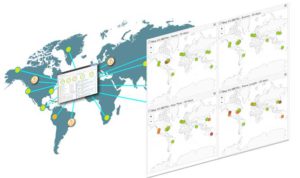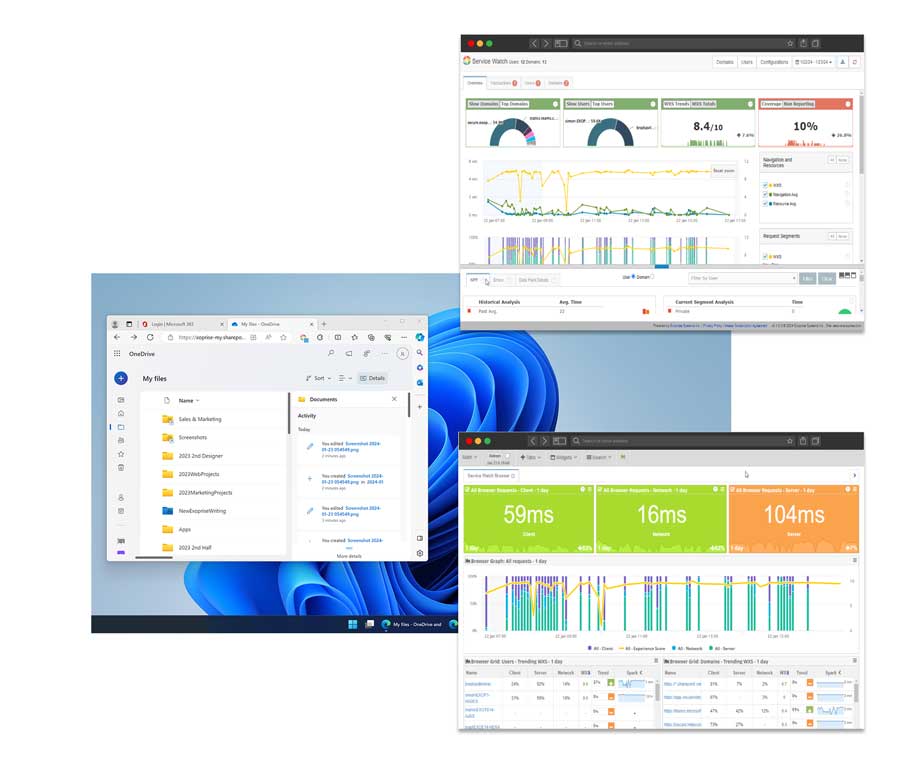With every webpage loaded, email sent, or video streamed, network traffic takes a complex journey…
Work environments, the network that supports them, and the network management tools to fix those work environments seem to have changed overnight. But the shift was one which was long in the making, several decades to be exact. With the acceleration of work from home due to the pandemic, SaaS services accelerated into a necessity. Along with this dramatic shift, network management shifted to accommodate SaaS and gone were seemingly static paradigms about work and networking.
A Brief History of Information, Computing, and SaaS
Information revolutions have long shaped human history and culture, dating back thousands of years. Writing systems brought changes to cultures in ancient history. Suddenly, cultures needed information to survive and thrive. Business, academics, engineering and more depended on information.
When Gutenberg invented the printing press, it was like turning on the Internet. Now common forms of transmitting information soon grew. Publishing houses and news providers appeared, namely newspapers and books, which are still in wide use after the digital revolution landed square in the lap of human culture before the advent of the internet.
With the advent of computing as we know it in the 1960s, the earliest form of SaaS appeared. Using wired dummy terminals connected to a mainframe, organizations employed enterprise-wide data entry, systems which persisted for many years.
And then the PC arrived and the Local Area Network followed. Finally, the Internet to connect the different networking systems, both local and wide.
SaaS in its current form arrived by 2000. While software installed directly on PCs remained prevalent, subscription services began eating away at software market share. Over time, software companies either failed due to market shifts to SaaS or migrated to subscription models of their software delivered over the cloud.
The pandemic sped up the use of SaaS like never before as companies shifted from office personnel to home-office employees. While many workers have returned to offices, companies have realized cost savings on floor space with the heavy use of remote computing, buoyed by equally inexpensive SaaS solutions.

SaaS is now the foundation of many businesses. As a result, networks have developed more complex interconnections to best deliver a wide array of information and communication services. Robust and resilient networks adapted to provide a multitude of services, many of which, including computing, are hosted elsewhere. SaaS is another technological revolution within the digital information age which has changed work environments including network management as much as writing systems and the printing press created major cultural shifts with changes that rippled for centuries. Now, those ripples affect culture in months, not centuries, decades or even years.
New Networking Standards
Networking long ago transformed from its simpler roots into complex backbones. Security policies and requirements have already developed more robust measures, introducing innovations such biometrics with SSO. Secure Access Service Edge (SASE) is now widespread as a standard and born from the necessity of SaaS.
Along with email and IP-based phone systems, audio-video conferencing and app sharing are now common far beyond the executive boardroom. Unified Communications as a Service (UCaaS) Teams and Zoom are now ubiquitous on a daily, if not hourly, basis.
Employees are more dependent than ever on network management to ensure access to necessary applications. Network traffic is no longer predominantly limited to the central office and occasional WAN connections to branch offices. Instead, the proliferation of SaaS applications means traffic runs securely to numerous cloud interfaces. Combined with security requirements, SaaS has added multiple layers of physical and digital networking.
Breaking Down the Changes
Here are some differences before the recent explosion of SaaS usage to the present:
- Before 2020, almost all employees worked from the office. Now, many work from home, co-located offices, or anywhere with varying schedules.
- As a result, traffic once almost exclusively hosted in main offices is now connected all over the internet. SaaS providers are linked to businesses securely. In some cases, dedicated links and underlying networking are needed for core functions such as UCC applications.
- As with network traffic, SaaS stretched security policies. Already, with virtual computing in place, security requirements over SDWANs moved to SSO authentication as well as SASE models. SaaS only hastened further network installation of security hardware to handle the remote traffic securely, especially to cloud-hosted SaaS applications.
- These changes required additional network modeling by IT staff. Administrators must account for the various forms of communication and data retention. Dedicated network segments must cover demanding core functions such as UCC applications, many of which are interwoven with SaaS application providers.
- Digital Experience Monitoring is now more important than ever, with the sensitivity to remote workers and their needs. As a result, accurate monitoring is required. Robust monitoring requires accurate assessment of the state of the network on all fronts, since high-performance tuning is necessary for adequate business operations.
Without argument, SaaS drove the growth of networking from hardware to traffic modeling to robust DEM-base monitoring.
How Exoprise Adapted
With all of these constantly evolving and moving pieces, monitoring the network performance of SaaS applications continues to get more complex. Making sure the right monitoring solution in place is crucial to ensure the end users have an optimal experience and SaaS applications are available and performing well. This, enhances business productivity, increases the bottom line and helps with employee retention of your best assets. And its made easy with a combination of CloudReady and Service Watch for proactive SaaS application monitoring combined with coverage everywhere from real-user monitoring.
Service Watch is an agent-based solution which resides on end user devices. Once installed on the device, all the required metrics are collected to ensure the users are not having diminished experiences. Much like other agent-based solutions, Service Watch collects the hardware performance data such as CPU, disk, memory, etc. However, no one else out there collects the rich application network performance data quite like Service Watch or captures performance comparisons across all the disparate resources.

CloudReady synthetic sensors, on the other hand, are script free synthetics which can be deployed within minutes. They can be configured to monitor the most critical of web applications such as Teams, Zoom, ServiceNow, SharePoint, and many more. These CloudReady synthetics emulate an end user accessing and using the SaaS applications while alarming on any metric that crosses the automatically computed, designated thresholds. Identify slow logins, outages, and errors and provide the required information to vendors to expedite troubleshooting.
Conclusion
Exoprise grew with the arrival of SaaS. Even network benchmarks and baselines are now crowdsourced to exceed necessary best practices. CloudReady provides lightweight SaaS metrics and fine-tuning. Service Watch provides analytics into computing health, even with varied OSs and device types, including mobile and virtual.
SaaS shaped the world of network management. The complexity continues to burgeon. Exoprise, continues to grow with the changing network management needs so businesses retain a solid computing footprint. Problem resolutions, once taking hours or days, are now attainable before the issues are even noticeable by users. Higher levels of network performance ensure all forms of information are adequately provided to remote users. System growth will continue, monitoring innovations will continue to be necessary, and Exoprise meets these challenges with unique solutions.


